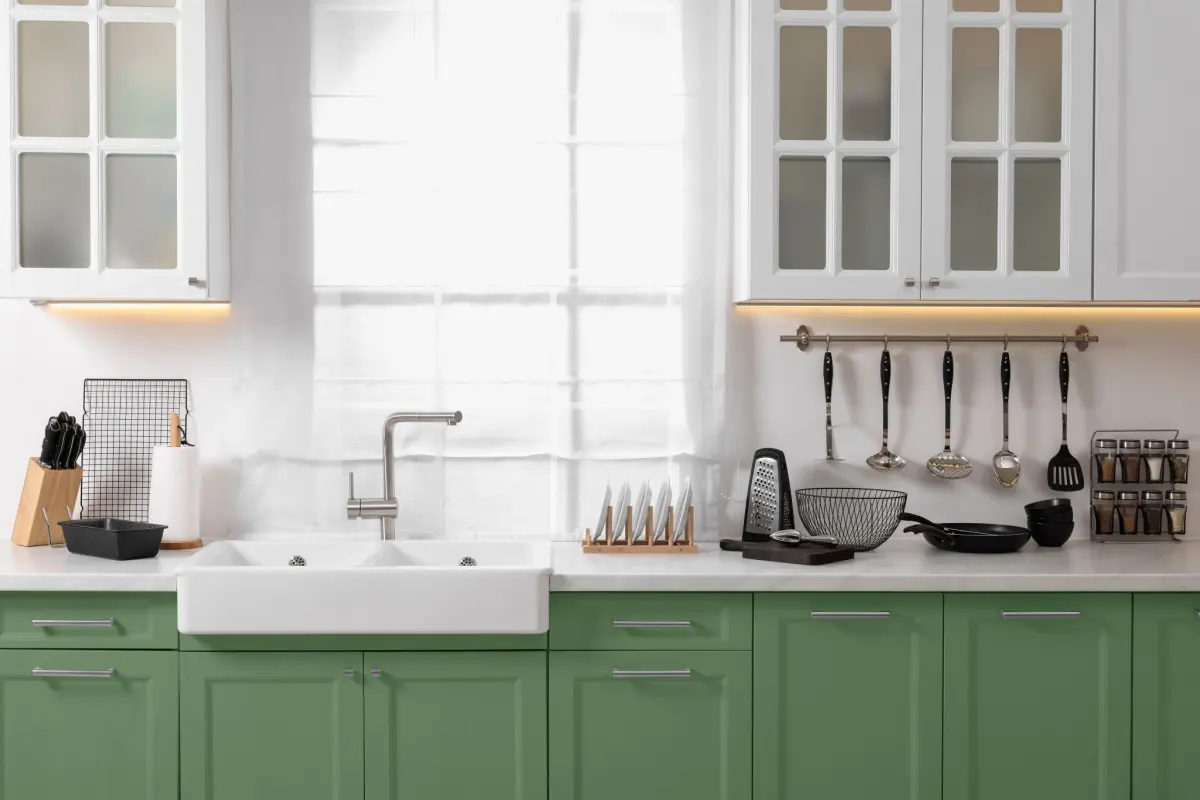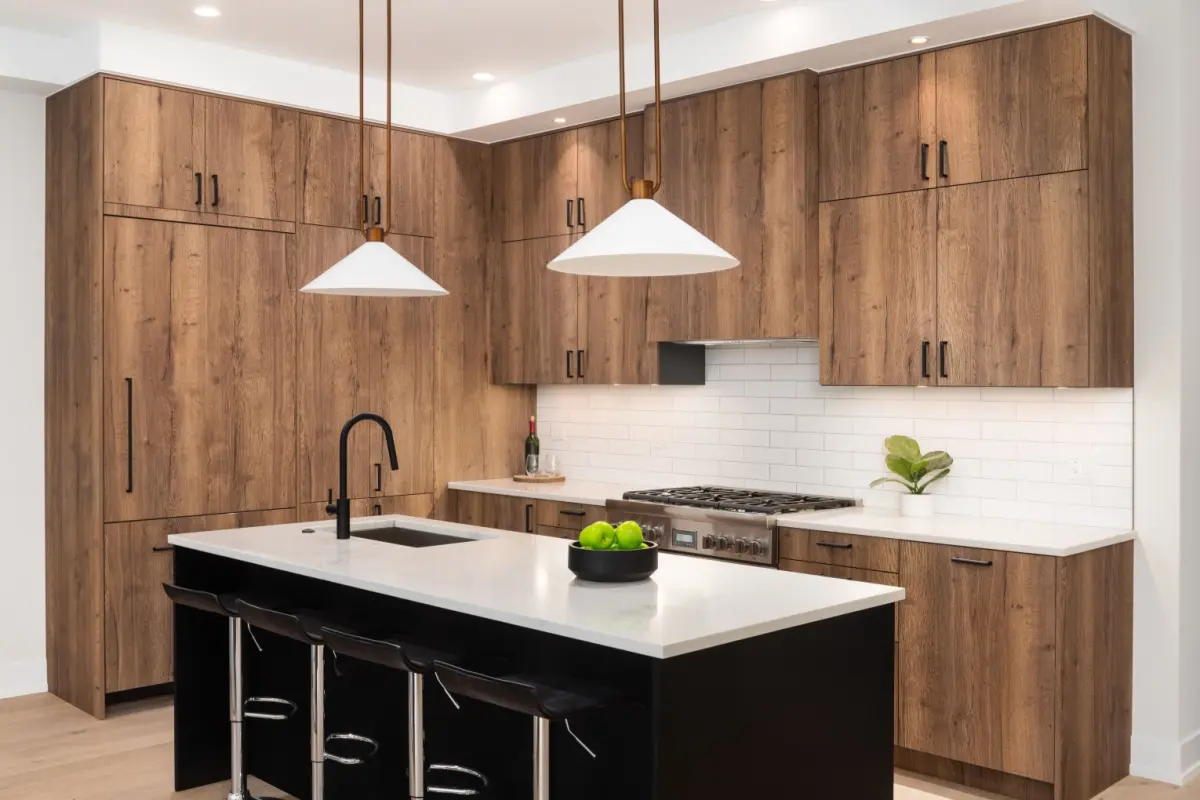If you’re exploring ways to design and remodel your kitchen, updating your cabinets can make a big impact. They’re an eye-pleasing storage solution that can set the tone for your kitchen’s overall aesthetic. Plus, kitchen cabinet styles have come a long way, offering countless materials and finishes that make it easy to achieve the look you want.
This guide will explain the different types of kitchen cabinets, styles, and materials, helping you make the best choice for your space.
Before selecting your kitchen cabinets, it’s essential to understand the variety available. How many types of kitchen cabinets are there? Most manufacturers break down their cabinet styles into three main categories.
Stock cabinets are an excellent choice for quickly renovating a kitchen or bathroom. They are affordable, easy to install, and can be produced in less time, making them popular with homeowners and contractors.
Considered to be regularly “in stock,” they are made in large quantities and available in standard sizes that accommodate most kitchens, such as 12-inch deep base cabinets or 24-inch wide wall cabinets.
Custom kitchen cabinets are known for being durable, long-lasting, and flexible. Because they are custom, your designer can assess your space, discuss your style, and create something unique.
Although custom cabinets are expensive, many people choose them for their uniqueness and durability.
Semi-custom cabinets are a happy medium between stock and custom. They come in standard “stock” sizes but can be tailored to meet your aesthetic needs. For example, you can modify the depth of your drawers, door fronts, and finishes.
These are popular choices for homeowners seeking a personalized look at a reasonable price.
Here are seven popular kitchen cabinet styles that you can choose from to personalize your kitchen even further:
Shaker cabinets offer clean, simple lines that complement any kitchen style. They are straightforward, simple cabinets with a flat paneled door and a natural wood trim, like maple, cherry, or oak.
Light colors like white or gray are popular paint finishes for shaker cabinets because they brighten a kitchen. In fact, white was the most popular cabinet color in 2024, according to a Statista survey of American homeowners.
Flat panel or slab cabinets have a modern, sleek design that creates a clean, smooth look in the kitchen. The flat surfaces and sharp lines help make the kitchen feel more open and spacious.
Flat pane cabinets are available in matte and glossy finishes, giving you options to fit any modern kitchen.
Glass-front cabinets showcase dinnerware or collectibles while protecting them from dust and grease. They offer more enclosed storage than open shelves, allowing only a panel to view the interior.
Most kitchen designs pair glass-front cabinets with other styles, like shaker or raised doors, for a cohesive look. While they can be expensive and require extra maintenance, they provide aesthetic appeal and functionality.
Beadboard cabinets add Scandinavian charm and a rustic, cozy vibe to your kitchen. The vertical slats create texture and depth, making them perfect for cottage or farmhouse-style spaces.
Even in minimalist kitchens striving for a high-end feel, beadboard can be used strategically as a textured design element. It can elevate a space when paired with exposed wood beams or distressed furniture.
Louvered cabinets add a unique touch to your kitchen. Their horizontal slats are vented, creating an airy, open feel often found in coastal and transitional spaces.
For bohemian, Asian zen, or coastal themes, louvered doors work well as accents on base, upper, or tall cabinets. Clean lines and layered texture create visual interest, so they act as a focal point in the room.
Open shelving offers a fresh, minimalist alternative to traditional cabinets, creating an airy, accessible kitchen. It’s perfect for displaying decor, cookbooks, or essentials, adding personality while keeping things practical and open.
Many small kitchen spaces incorporate open shelving to make the space feel bigger.
Industrial-style cabinets use metal, wood, and glass for a factory-like look. They often have exposed hinges, handles, and hardware. This style is perfect for kitchens that want a rugged, modern feel with an industrial touch.
When planning a kitchen remodel, choosing the right materials for your cabinets is essential to balancing style, durability, and budget. If you’re wondering how much it costs to renovate a kitchen, remember that the material you select will significantly impact the total cost. Let’s explore the most commonly used materials for kitchen cabinets and what makes each unique.

The right cabinet can make a big difference in how your kitchen looks. Done right, your cabinet choices improve organization, visual appeal, and durability.
Look for cabinet designs that prioritize storage and organization, such as keeping cooking utensils and cookware close to prep areas for easy access. Consider the depth of your kitchen gadgets and the size of your plates. Rarely used items can be stored in a pantry cabinet, freeing up space for essentials and keeping the kitchen clutter-free.
It is also essential to choose cabinets that can withstand daily use, heat, moisture, and spills. High-quality materials like solid wood or premium MDF ensure long-lasting performance and durability.
Plus, cabinetry will be your most prominent design element in the kitchen, so it’s important to pick a style you love. Today’s suppliers often sell cabinets that balance look and function, making it easy for you to choose a finish that matches your ideal aesthetic.
There are several steps to measuring your cabinets accurately. Let’s break it down:
Kitchen cabinets are evolving just like everything else. This year’s design trends are warm, inviting, and multifunctional — and the cabinets themselves? They’re showpieces.
Kitchens will be transformed into cozy, social hubs through textural layering. This means mixing wood, stone, and metal materials with textiles such as rugs and upholstered seating.
These designs will focus on clean lines and uncluttered spaces, which fit nicely with the minimalist aesthetic that has been prevalent since 2020.
Sustainability and eco-friendly living will continue to drive cabinetry design. Expect to see materials with reduced environmental impact, such as bamboo, reclaimed wood, recycled glass, and natural stone, taking center stage.
Upgraded kitchens will have built-in appliances and smooth faces for a clean, modern look. Handleless designs, smart devices, and energy-saving tech will make kitchens more functional and easier to use.
All white kitchens are a thing of the past, according to this year’s design trends. Warm, earthy tones inspired by terracotta, taupe, and soft browns are now in. These natural hues offer a fresh, inviting alternative to traditional colors, creating a welcoming atmosphere. They also blend seamlessly with various kitchen styles.

Neutral shades like pistachio green, sage, and blush pink remain timeless, while bolder tones like emerald green, ruby red, and deep sapphire add sophistication and depth. What’s more, we’re seeing more cabinets accented with touches of gold and brass — like the range hood’s trim and the drawer pulls.
Two-tone cabinetry is also popular. By contrasting the base and upper cabinets, homeowners can create a modern, balanced look. Here, you might mix a crisp white upper with a dark black lower and soften the look with a pale gray backsplash.
It seems the word of the year is “declutter,” and new cabinets are being designed with storage in mind. Homeowners are investing in kitchens that optimize cabinet interiors with practical organizational features, such as partitions, rolling drawers, and deeper shelves. The more usable, the better.
As you consider your design options and budget, one of your main choices will be whether you opt for custom or stock cabinets.
Custom cabinets are made to fit your specific space and style, offering endless design flexibility. You can choose materials, finishes, sizes, and features that suit your needs. While more expensive, custom cabinets provide a unique, personalized look and superior craftsmanship. If custom is what you’re after, check with your home improvement contractor to see if they offer kitchen remodel financing to help cover the cost.
Stock cabinets are premade in standard sizes and designs, making them a more budget-friendly option. They are also available in limited styles, finishes, and sizes but are quicker to install. Stock cabinets are ideal for a cost-effective, functional solution without needing a completely personalized design.
| Stock Cabinetry | Custom Cabinetry |
| Less expensive | More expensive |
| Easier to install | Installation can be more involved |
| More readily available; faster lead time | Made to order; slower lead time |
| Limited design, size, style, color, finish options | Ample design, size, style, color, finish choices |
| Best for standard kitchens with standard measurements and shapes | Ideal for irregular-shaped kitchens or tricky corners |
There are three main types of kitchen cabinets: stock cabinets, custom cabinets, and semi-custom cabinets. Each type offers different levels of flexibility, price, and design options.
Stock cabinets are the most popular choice due to their affordability and availability in standard sizes and designs. They are commonly chosen for quick kitchen renovations or budget-friendly projects.
There are three types of cabinets: entry-level, mid-grade, and high-end. Entry-level cabinets are budget-friendly and basic, while high-end cabinets offer premium materials and custom features for a more luxurious finish. When considering your kitchen renovation budget, most home renovation experts recommend sticking to the 30% rule.